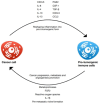Cancer-associated inflammation: pathophysiology and clinical significance
- PMID: 36260158
- PMCID: PMC9579684
- DOI: 10.1007/s00432-022-04399-y
Cancer-associated inflammation: pathophysiology and clinical significance
Abstract
Purpose: Cancer cells, despite stemming from the own cells of their host, usually elicit an immune response. This response usually enables elimination of cancer at its earliest stages. However, some tumors develop mechanisms of escaping immune destruction and even profiting from tumor-derived inflammation.
Methods: We summarized the roles of different immune cell populations in various processes associated with cancer progression and possible methods of reshaping tumor-associated inflammation to increase the efficacy of cancer therapy.
Results: Changes in various signaling pathways result in attraction of immunosuppressive, pro-tumorigenic cells, such as myeloid-derived suppressor cells, tumor-associated macrophages, and neutrophils, while at the same time suppressing the activity of lymphocytes, which have the potential of destroying cancer cells. These changes promote tumor progression by increasing angiogenesis and growth, accelerating metastasis, and impairing drug delivery to the tumor site.
Conclusion: Due to its multi-faceted role in cancer, tumor-associated inflammation can serve as a valuable therapy target. By increasing it, whether through decreasing overall immunosuppression with immune checkpoint inhibitor therapy or through more specific methods, such as cancer vaccines, oncolytic viruses, or chimeric antigen receptor T cells, cancer-derived immunosuppression can be overcome, resulting in immune system destroying cancer cells. Even changes occurring in the microbiota can influence the shape of antitumor response, which could provide new attractive diagnostic or therapeutic methods. Interestingly, also decreasing the distorted tumor-associated inflammation with non-steroidal anti-inflammatory drugs can lead to positive outcomes.
Keywords: Cancer; Immunotherapy; Inflammation; Oncology.
© 2022. The Author(s).
Conflict of interest statement
The authors declare no conflict of interest.
Figures



References
-
- Bommareddy PK, Shettigar M, Kaufman HL (2018) Integrating oncolytic viruses in combination cancer immunotherapy. Nat Rev Immunol 18(8):498–513 - PubMed
Publication types
MeSH terms
LinkOut - more resources
Full Text Sources
Medical

